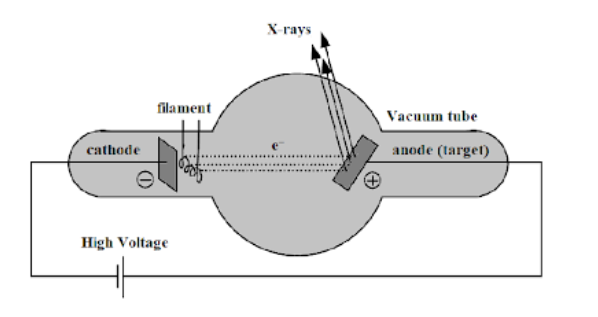
Answer
469.5k+ views
Hint: X-rays are a type of radiation called electromagnetic waves. The modern technology consists of Coolidge tubes for the production of X-rays. For the production of X-rays, the target should have a high atomic number along with good heat storage capacity and low rate of evaporation.
Complete step by step answer:
An X-radiation is a penetrating form of high energy electromagnetic radiation. They usually have a wavelength ranging from \[10\text{ picometres}\] to \[\text{10 nanometres}\] and corresponding frequencies in the range of $30\text{ petahertz}$ to $30\text{ exahertz}$, that is, $3\times {{10}^{15}}Hz$ to $3\times {{10}^{18}}Hz$. The energy of X-rays lies in the range $124eV$ to $124KeV$.
X-rays are produced when the fast moving electrons strike a metal target of suitable material.
The basic requirements for the production of X-rays are:
A source of electrons
Effective means of accelerating the electrons and
A target of suitable material and high atomic weight.
The modern type of X-ray tube designed by Coolidge consists of a highly evacuated hard glass bulb containing a cathode and an anode target. The cathode target is heated by passing electric current through it from a low tension battery. Anode is the component in which X-rays are produced. The function of anode is to convert the electricity into X-rays and dissipate the heat in the process. For this purpose, material such as molybdenum is used with a high atomic number which has good heat storage capacity and low rate of evaporation.

The electrons are emitted by the process called as thermionic emission from the cathode. The filament of the tube is surrounded by a molybdenum cylinder kept at a negative potential to the filament. Thus, the electrons emitted from the filament are collimated into a fine pencil of electron beam. This fine electron beam is called X-rays.
Molybdenum is used as a target in Coolidge tubes for the production of X-rays.
Hence, the correct option is B.
Note:
The Coolidge tube has anode and cathode targets. The anode is the component in which X-rays are produced. The intensity of X-rays depends upon the total number of electrons striking the target, that is, the rate of emission of electrons from the cathode filament. This can be controlled by varying the amount of filament current.
Complete step by step answer:
An X-radiation is a penetrating form of high energy electromagnetic radiation. They usually have a wavelength ranging from \[10\text{ picometres}\] to \[\text{10 nanometres}\] and corresponding frequencies in the range of $30\text{ petahertz}$ to $30\text{ exahertz}$, that is, $3\times {{10}^{15}}Hz$ to $3\times {{10}^{18}}Hz$. The energy of X-rays lies in the range $124eV$ to $124KeV$.
X-rays are produced when the fast moving electrons strike a metal target of suitable material.
The basic requirements for the production of X-rays are:
A source of electrons
Effective means of accelerating the electrons and
A target of suitable material and high atomic weight.
The modern type of X-ray tube designed by Coolidge consists of a highly evacuated hard glass bulb containing a cathode and an anode target. The cathode target is heated by passing electric current through it from a low tension battery. Anode is the component in which X-rays are produced. The function of anode is to convert the electricity into X-rays and dissipate the heat in the process. For this purpose, material such as molybdenum is used with a high atomic number which has good heat storage capacity and low rate of evaporation.

The electrons are emitted by the process called as thermionic emission from the cathode. The filament of the tube is surrounded by a molybdenum cylinder kept at a negative potential to the filament. Thus, the electrons emitted from the filament are collimated into a fine pencil of electron beam. This fine electron beam is called X-rays.
Molybdenum is used as a target in Coolidge tubes for the production of X-rays.
Hence, the correct option is B.
Note:
The Coolidge tube has anode and cathode targets. The anode is the component in which X-rays are produced. The intensity of X-rays depends upon the total number of electrons striking the target, that is, the rate of emission of electrons from the cathode filament. This can be controlled by varying the amount of filament current.
Recently Updated Pages
Fill in the blanks with a suitable option She showed class 10 english CBSE

TISCO is located on the banks of which river A Tungabhadra class 10 social science CBSE

What is greed for clothes A Simply desire to have them class 10 social science CBSE

What does the 17th Parallel line separate A South and class 10 social science CBSE

The original home of the gypsies was A Egypt B Russia class 10 social science CBSE

The angle between the true north south line and the class 10 social science CBSE

Trending doubts
Fill the blanks with the suitable prepositions 1 The class 9 english CBSE

How do you graph the function fx 4x class 9 maths CBSE

When was Karauli Praja Mandal established 11934 21936 class 10 social science CBSE

Which are the Top 10 Largest Countries of the World?

What is the definite integral of zero a constant b class 12 maths CBSE

Why is steel more elastic than rubber class 11 physics CBSE

Distinguish between the following Ferrous and nonferrous class 9 social science CBSE

The Equation xxx + 2 is Satisfied when x is Equal to Class 10 Maths

Differentiate between homogeneous and heterogeneous class 12 chemistry CBSE




